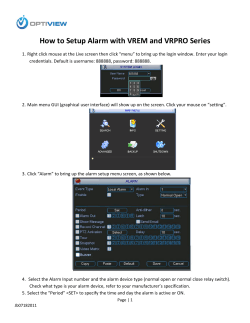
TBox RTUs — How to configure Alarm Scheduling by Vishal Prakash
TBox RTUs — How to configure Alarm Scheduling by Vishal Prakash TECHNICAL BRIEF When working with the TBox RTUs, it is possible to schedule the sending of alarms messages based on time and date. The TBox is smart enough to even take programmed holidays into account. The scheduling is part of the extensive alarm management system that is standard in every TBox RTU. A brief summary of the alarm capabilities in the TBox RTUs: • Detect alarm conditions based on user configurable conditions • Send alarms to the “end point” without any SCADA intervention or master device • Simultaneously send alarms of different types to multiple recipients • Receive alarm acknowledgement via SMS or e-mail • Ability to add a debounce filter to each alarm • Send real time information as part of the alarm message • Internal log of all alarms, regardless of the recipient that can be attached to a report • CSV, TXT, or XML reports and Historical Trend Data as alarm message attachments So, how do we do this and why is this useful? First, the “How do we do this?” The following is an abbreviated step-by-step guide. It is assumed that the user has a working knowledge of TWinSoft and TBox RTUs. The example in this document deals with sending an e-mail type SMS alarm. Steps one through six summarize how to send a simple e-mail alarm message. 1. Open TWinSoft. 2. Ensure the correct model of the TBox RTU is selected. 3. Program to RTU as required. 4. Configure the SMTP Server under “IP Parameters → SMTP Server.” This allows the TBox to connect to an external mail server and send the alarm. Figure 1: Configuring the SMTP Server in a TBox www.servelec-semaphore.com TECHNICAL BRIEF 5. Now, under “Alarms → Recipient,” configure the recipient who is going to receive the Alarm Message when the condition is true/false. An alarm recipient group can be created, if appropriate. 6. Under “Alarms → Condition,” the user can configure the actual alarm condition and tie it to the “Recipient.” Simple, isn’t it? Now let’s take a real world situation — a treatment plant or a group of oil well pads, both of which would require round the clock maintenance. Typically, multiple individuals or groups of individuals will be responsible for the maintenance of such facilities during different times of the day. In such instances, how does the TBox ensure that the alarm is sent to the right person or group? Well, as it turns out, this is truly simple, like everything else in the TBox. Keep reading to see how this is achieved with just a few simple clicks! 7. Go to “Alarms → Time Slices” to create Shift times. In the example below, there is a shift from 8:00 a.m. to 3:59 p.m., 4:00 p.m. to 11:59 p.m., Midnight to 7:59 a.m. There are two additional shift times — in 12 hour slots. See further below as to why these were created. Figure 2: Time Slice configuration — part of Alarm Scheduling 8. Go to “Alarms → Holidays” to configure national, local holidays. This is optional and not required to enable the alarm scheduling functionality in the TBox RTU. See example “Holiday” configuration below. Figure 3: Configuring “Holidays” in the TBox RTU www.servelec-semaphore.com TECHNICAL BRIEF 9. Go to “Alarms → Timetables” to link the time slice and holidays — see example below. Figure 4: Example “Timetables” configuration, which connect Time Slices and Holidays 10. Now, go back to “Recipients” and tie-in the “Timetables.” See example below. Figure 5: Binding in Recipient and Timetables Now to the second part — why is this feature useful? Well, there are many obvious reasons as to why this feature is useful. So rather than talk about the obvious, let’s continue looking into what else the TBox Alarm Scheduling can do for you, the user. www.servelec-semaphore.com TECHNICAL BRIEF In four simple steps, we were able to configure alarm scheduling in the TBox. In the figures shown above there is a “Runtime Parameters” tab. Configuration of parameters in this tab allows the user to access information such as the shift hours, holidays, and alarm recipients dynamically on a TBox web page. This is immensely useful and powerful. Why? A maintenance technician, with the proper login credentials, can make changes without having to reconfigure the RTU. The authorized personnel do not need access to the programming software — they simply bring up the web page and make the required changes. A change made to the “runtime” parameters on a live system is maintained after power recycles which is very useful. There are many more advanced features — like configuring a delay in processing an alarm message, automatically sending an alarm message when the alarm condition becomes false, replying back to an alarm message, alarm escalation, using the retries to disable sending messages to a recipient, and many more. For more information on any of the above, please refer to the online help in TWinSoft or call your local Semaphore representative. In the next issue, the focus will be, exclusively, on the power of the “Runtime Parameters” feature. Please visit our website, www.servelec-semaphore.com/mytbox, (must be a registered user) for the latest versions of the TBox manuals and TWinSoft programming software. The portal also contains other useful information such as example programs, FAQ, and tips. www.servelec-semaphore.com U.S.A. Semaphore Americas Inc. 280 Wekiva Springs Road Suite 3030 Longwood, FL 32779 U.S.A. P +1 (844) 475 8020 support.americas@servelec-semaphore.com Australia Semaphore Unit 8, 3-5 Gilda Crt Mulgrave, Victoria 3170 Australia P+61 (03) 8544 8544 F +61 (03) 8544 8555 Info.kingfisher@servelec-semaphore.com Europe Semaphore Belgium Waterloo Office Park — Building “M” Dreve Richelle, 161 B-1410 Waterloo Belgium P+32 (2) 387 42 59 F +32 (2) 387 42 75 info.tbox@servelec-semaphore.com © 2013 Semaphore. All rights reserved. TBOX is a trademark of Semaphore. All other marks may be trademarks of their respective owners. 1361021 03/14
© Copyright 2025











